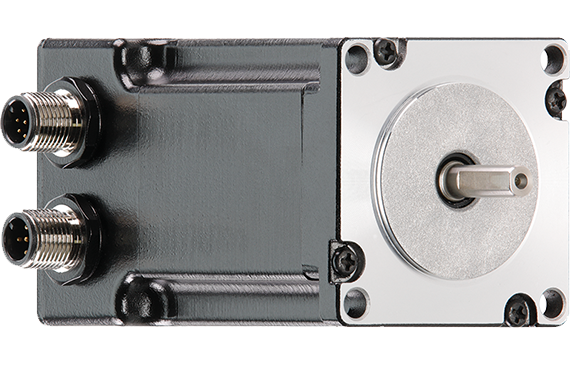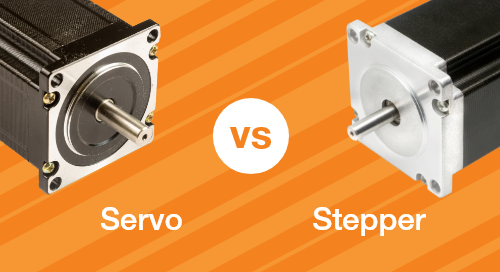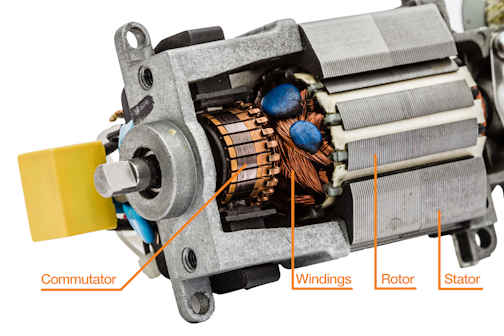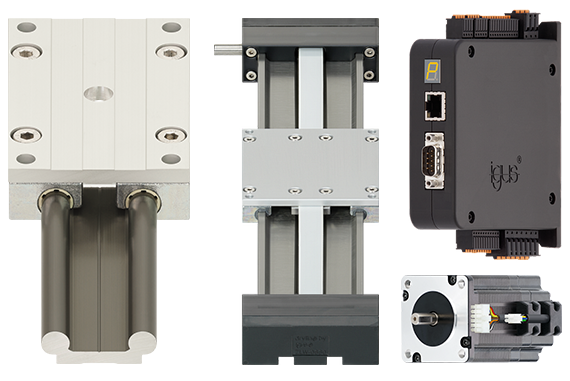Servo Motor vs. Stepper Motor: how to choose the right one
In engineering applications requiring precise control over motion, both servo and stepper motors are popular solutions, each offering unique advantages suited to different tasks. Selecting the appropriate motor for your project is crucial to ensure optimal performance and efficiency. Here, we’ll delve into the technical distinctions, control mechanisms, and practical applications of each motor type to help you determine which is best suited for your needs.
What is a servo motor?
A servo motor is a closed-loop system that integrates feedback control to achieve precise positioning, speed, and torque. It typically uses a high-resolution encoder, such as an optical or magnetic rotary encoder, to measure the shaft’s actual position and send this data back to a control loop. This allows the system to make real-time adjustments, maintaining accuracy even under varying loads or external disturbances.

Servo motors can operate at high speeds while delivering significant torque. The closed-loop nature of the servo motor’s control system enables it to maintain high torque even at low speeds, which is particularly beneficial for applications requiring consistent power output. For example, in industrial robotics and CNC machines, servo motors offer precise control and adaptability for multi-axis movement.
Technical specifications
- Control method: Pulse-width modulation (PWM) signals, often paired with PID controllers, regulate motor position and speed
- Feedback system: Uses encoders or resolvers for feedback
- Torque response: Excellent torque across speed ranges, high torque at low speeds
- Applications: Robotics, CNC machines, automation systems with variable loads
Advantages
- High accuracy: Servo motors offer exceptional accuracy and repeatability, making them suitable for tasks that require precise positioning.
- Speed and torque control: The closed-loop system allows servo motors to maintain a constant speed and deliver varying levels of torque, even under changing load conditions.
- Reduced heat generation: Servo motors are more efficient compared to stepper motors, resulting in lower heat dissipation during operation.
Limitations
- Cost: Servo motors are generally more expensive than stepper motors, mainly due to the added cost of feedback devices and complex control systems.
- Complex Control: Configuring and tuning the control parameters for servo motors can be challenging and requires specialized knowledge.
What is a stepper motor?
Stepper motors (sometimes referred to as a spindle motor) are open-loop systems that use magnetic fields generated by multiple coils to rotate the rotor in discrete steps, typically measured in degrees per step. They are controlled by sending pulses through these coils in a specific sequence. Each pulse moves the rotor by a fixed angle, allowing for predictable movement without the need for a feedback system. Stepper motors are favored in applications where precision and repeatability are critical but where high torque and complex feedback systems are unnecessary.

The stepping mechanism limits torque at higher speeds, and without closed-loop control, stepper motors can experience issues like resonance and missed steps under high load. Despite this, they excel in situations requiring exact incremental movements, such as 3D printing and X-Y plotting.
Technical specifications
- Control method: Pulse signals direct the motor’s step sequence, often controlled via microstepping for smoother movement.
- Feedback system: Typically operates without feedback (open-loop); closed-loop versions exist but are less common.
- Torque response: High holding torque at low speeds but reduced torque as speed increases.
- Applications: 3D printers, laser cutters, and other low-load, high-precision applications.
Advantages
- Cost-effectiveness: Stepper motors are more affordable than servo motors, making them a popular choice for budget-conscious projects.
- Simple control: The open-loop nature of stepper motors simplifies their control, and they are relatively easy to implement without requiring complex control algorithms.
- Holding torque: Stepper motors can hold a position without the need for continuous power, which is beneficial in static holding applications.
Limitations
- Limited high-speed performance: Stepper motors suffer from a phenomenon called "resonance" at higher speeds, reducing their effectiveness in high-speed applications.
- Less accurate: Stepper motors may experience positioning errors due to missed steps, especially in dynamic load conditions.
Difference in pole count between servo motors vs. stepper motors
The number of poles is a critical differentiator between servo and stepper motors, directly impacting their control and performance characteristics.
Stepper Motors: Typically, stepper motors have a high pole count, often with 50-100 poles or more. This high pole count allows them to perform fine, incremental steps.
In stepper motors, each pole pair can move the rotor a precise angular distance, with the number of poles setting the base for resolution (steps per revolution). This makes them ideal for applications requiring high precision without feedback.
Servo Motors: Servo motors generally have fewer poles, typically between 4 and 12. The lower pole count means they rely more on electronic control and feedback mechanisms rather than intrinsic stepping to achieve smooth and controlled motion.
With fewer poles, servo motors can reach much higher rotational speeds compared to stepper motors, as the rotor completes fewer magnetic transitions per revolution.
Impact of Pole Count on Applications: The high pole count in stepper motors is suited to low-speed, high-precision tasks, while the low pole count in servo motors allows for efficient high-speed operations.
In addition, the lower pole count in servo motors makes them more responsive in applications requiring real-time position adjustments, like robotics or CNC machining, where the feedback loop plays a significant role in maintaining performance.
Control precision: encoder feedback vs. open-loop stepping
Servo motors use high-resolution encoders that provide real-time feedback on position and speed, enabling them to adjust for load changes or deviations. Stepper motors, on the other hand, lack inherent feedback, making them susceptible to positional inaccuracies under variable loads or high-speed operation.
Comparing efficiency and reliability
Servo motors, due to their closed-loop systems, offer high efficiency across a range of speeds. They also have a dynamic response to fluctuating loads, making them ideal for applications where reliability and adaptability are paramount. Stepper motors, while cost-effective and mechanically simple, may lose efficiency at high speeds due to decreased torque. Nonetheless, their simplicity can offer higher reliability for specific use cases where low to moderate speed and high repeatability are key.
Stepper vs. Servo: How to choose the right one
Finally, it comes time to choose the type of motor that best suits your application. However, there are a few key considerations that need to be made and questions answered before doing so.

Considerations
- Precision requirements: If your application demands high precision and accuracy, especially in dynamic environments, a servo motor may be the better choice.
- Budget constraints: For cost-sensitive projects with moderate accuracy needs, a stepper motor could be a suitable option.
- Control complexity: Evaluate your team's expertise and the complexity of the control system required. If you lack experience in advanced control algorithms, a stepper motor might be more manageable.
Conclusion
In summary, the decision between using a servo motor vs. stepper motor heavily depends on the specific requirements of your engineering application. Servo motors offer unparalleled precision, speed, and torque control but come at a higher cost and require more sophisticated control systems. On the other hand, stepper motors are budget-friendly and straightforward to control, but may not deliver the same level of accuracy and high-speed performance. By carefully evaluating your project needs and considering the advantages and limitations of each motor type, you can make a well-informed choice to achieve optimal results in your engineering endeavors.
Frequently Asked Questions
Stepper motors typically operate in an open-loop system: the controller sends a command to move a specific number of steps There is generally no feedback to confirm the actual position. Servo motors, conversely, utilize a closed-loop system with a feedback device. The controller constantly monitors the motor's actual position and speed and adjusts the current to correct any error, ensuring high accuracy.
Stepper motors generate high torque at low speeds, but their torque drops significantly as speed increases (typically above 1,000 RPM). Servo motors maintain high, consistent torque across a wide speed range, often reaching much higher top speeds (2,000+ RPM). Servos can also provide momentary peak torque for rapid acceleration.
Servo motors generally offer superior accuracy and no risk of position loss because their closed-loop system continuously verifies and corrects the position using the encoder feedback. Stepper motors, in a standard open-loop configuration, can suffer from "lost steps" under excessive load or high acceleration, leading to positional errors without the system knowing.
Stepper motor systems are typically less expensive due to their simpler design and open-loop control, which doesn't require an expensive encoder or complex drive. Servo motor systems are generally more expensive because they require an encoder, a more complex drive, and often use higher-cost components like rare-earth magnets
A stepper motor is ideal for applications requiring:
A servo motor is better suited for applications requiring:
Servo motors are generally more energy efficient because their closed-loop system only draws the current needed to move the load or maintain the commanded position. Stepper motors consume continuous current, even when stationary, leading to more power consumption and heat generation.
A closed-loop stepper motor, sometimes called a hybrid servo, is a variation of the standard stepper motor that includes an encoder. This system gains the benefit of feedback, which allows the motor to detect and correct for lost steps, improving accuracy and efficiency while still using a stepper-style motor design. This option bridges the performance gap but adds to the cost and complexity compared to a traditional open-loop stepper.



